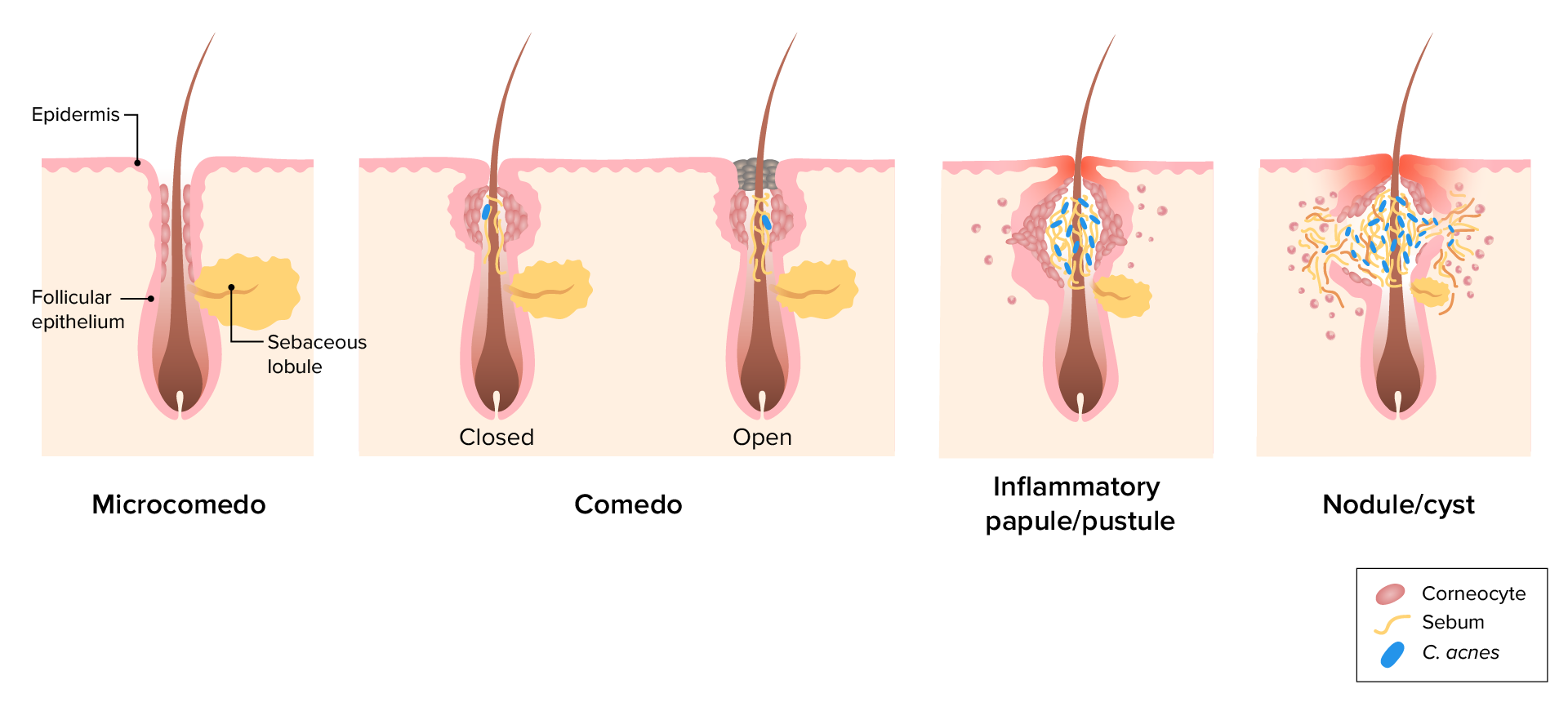Playlist
Show Playlist
Hide Playlist
Acne in Darker Skin: Presentation and Differential Diagnosis
-
Slides Acne in Darker Skin Presentation and Differential Diagnosis.pdf
-
Download Lecture Overview
00:01 So that's it about etiology. 00:03 Then we're going to move on and talk about how does acne present. 00:07 What are we going to look for? What do we see in a patient who presents with acne? Well there is a type of acne called a noninflammatory acne or comedogenic acne. 00:18 Comedogenic is due to hyperkeratotic plaque, which is composed of corneocytes. 00:25 Corneocytes are keratinocytes. 00:27 The cells that we spoke about when we were talking about the basic physiology. 00:30 These are found in the lower portion of the follicular infundibulum. 00:35 So these cells then obstruct the follicular infundibulum. 00:41 So then the other type we're going to talk about now is where you have open comedones. 00:47 And this is what is normally labeled as blackheads by the layperson. 00:53 So this is due to actually to oxidization of the fatty acids within the follicular duct. 01:02 And you can also get dilatation and plugging at the follicular orifice on the skin surface. 01:08 And that's what you see clinically as open comedones or blackheads. 01:14 What about closed comedones. 01:15 Is a similar concept, but this time they are not open, so they look white and they are frequently called whiteheads. 01:23 Here what actually happens is that you get plugging of the keratotic follicle, which occurs at the follicular orifice below the skin surface. 01:35 The comedone is the precursor lesion to inflammatory acne. 01:40 If you don't see comedones then that is not acne. 01:44 We will talk about this when we discuss some of the differentials for acne. 01:50 Steroids of course, cause a comedones as well. 01:54 And as I mentioned, this is a serious problem amongst skin of color patients, particularly in my country. 02:03 So we are now going to talk about the various types of acne, the papulopustular acne. You get superficial inflamed papules or pustules. 02:14 We defined these on the other day. 02:16 What a papule is and what a pustule is. 02:18 And this is where you get a sterile pustule in acne. 02:22 It's not infective, it's merely leukocytes that you see. 02:26 And then there's nodular cystic acne you see here tender, inflamed, much deeper with scarring and sinuses and tracks. 02:35 And this type of acne tends to result in residual scarring. 02:40 So what are some of the predilection sites? Where does acne occur commonly on the face. 02:46 You can see it on the upper chest on the back as well as shoulders. 02:50 So it's very important when you see patients with acne to also ask or examine them to see whether there's truncal involvement as well, because that will determine your management. 03:01 You want to move on now and talk about the complications of acne. 03:05 The first one that we want to dwell on is post-inflammatory hyperpigmentation. 03:11 This results at the site of an active or resolving lesion, and this is more unique and more common in skin of color patients. 03:21 It is actually made worse by skin picking because if you pick or interfere with your acne, you are actually triggering inflammation and causing more pigmentation. 03:33 As I mentioned, it is there's a higher risk of post-inflammatory hyperpigmentation, or what we call PIH in those with darker skin pigmentation, and it can actually persist for months in dark skin. 03:47 So I think it's important for healthcare physicians to realize that this is a condition that actually affects patients of skin of color, and it needs to be managed. 03:58 So just treating acne on its own and not focusing on the hyperpigmentation may be problematic. 04:06 It can resolve spontaneously but takes time, so intervention and active treatment is recommended. 04:14 The second complication of acne is scarring, and it tends to occur more with inflammatory acne or what we can call acne scarring. 04:25 So what are the types of scars that we see? Atrophic or ice pick or boxcar scars? As you can see on the picture, which I will show you. 04:34 The second type is hypertrophic scars. 04:37 And you can also get keloids, which can be a real challenge to manage. 04:42 Of course, we cannot forget the impact of acne on the quality of life of those affected. 04:49 So the psychosocial impacts of acne, it can actually lead to low self-esteem. 04:55 We see a number of young adults who cannot take pictures. 04:59 They don't want to be involved in anything because of the acne, because remember dermatologic conditions are so visual, everybody can see what you have. 05:07 Whereas if you talk about, for example, cardiology, nobody can see that your heart is failing or your liver is failing. 05:14 But with skin it is so visual. 05:16 So factors of low self-esteem are really paramount. 05:20 And it's important for doctors to be aware of this and address this when they see patients. 05:24 So anxiety and depression it's been shown that some patients can actually develop anxiety and depression because of acne. You also get scarring, which I mentioned the PIH and Keloids more so in darker skin. And sometimes this can be due to secondary infection. 05:44 Folliculitis may develop with prolonged use of topical antibiotics because of the resistance that is caused due to long term use of antibiotics. 05:54 So it's important that we also think about this. 05:58 We are now going to move on to diagnosis of acne. 06:03 So diagnosis of acne is mainly clinical. 06:07 Usually it's a clinical diagnosis and not many investigations are actually needed. 06:13 But it's important also to know how to actually identify whether the patient has got mild, moderate or severe acne. Patients with mild acne will have less surface area involved of the acne, less inflammation, and less scarring. 06:31 And then patients with moderate acne will have perhaps half 50% of the surface area of the face that is involved. But again, it's not about the surface area that is involved. 06:41 It's about the type of lesions that you see. 06:44 If patients have got nodules and cysts that can still be classified as severe acne, and severe acne tends to involve a larger area of the face of the face. 06:56 And in addition, patients may have involvement of the trunk that is, the anterior chest and the back In addition to that, patients may have lesions that are nodules, sinuses and cysts, and they may heal with scarring. 07:14 That is the scars that we spoke about. 07:16 Remember, it's not so much about the area that is involved and the type of lesions. 07:21 It's also about how the acne affects the patient, the quality of life and the psychosocial impact. 07:28 So a patient may have one or 2 or 3 lesions. 07:30 But if those lesions are cystic and nodular, that can be classified as severe acne because it's important how the patient heals. 07:39 And remember we spoke about post-inflammatory hyperpigmentation, which is a unique feature of patients with dark skin or skin of color. 07:47 And this is an element of acne that we need to be aware of and target treatment for. 07:55 Because you may clear all the acne, clear all the active lesions, but if there's still post-inflammatory hyperpigmentation, that still affects the patient. 08:04 So that's kind of a summary of how we actually classify acne and how we treat the different types of acne. The differential diagnosis. 08:13 Okay. For example, what can mimic acne. 08:16 What can look like acne and confuse you. 08:19 There's a condition called rosacea, eosinophilic folliculitis, pityrosporum folliculitis, pseudofolliculitis barbae, which we see mainly in men after shaving. 08:31 They get ingrowth of the hair, which causes a folliculitis. 08:35 And again this condition. We will talk about it later. 08:39 It's more common in men of African ancestry. 08:44 You can also get sebaceous aplasia as a condition that can be confused with acne. 08:52 And of course molluscum contagiosum, which is a viral infection, can also be easily confused with closed comedonal acne.
About the Lecture
The lecture Acne in Darker Skin: Presentation and Differential Diagnosis by Ncoza Dlova is from the course Inflammatory Diseases in Patients with Darker Skin.
Included Quiz Questions
What is a defining characteristic of a closed comedone in acne?
- Plugging of the keratotic follicle below the skin surface
- Oxidation of fatty acids within the follicular duct
- Presence of bacterial colonization on the surface
- Formation of inflammatory papules
- Development of dermal nodules
Which finding would classify a patient's acne as severe, even if only a few lesions are present?
- Presence of nodules and cysts
- Multiple open comedones on the forehead
- Involvement of 50% of facial surface area
- Presence of post-inflammatory erythema
- Multiple superficial pustules
Which complication of acne is particularly significant in patients with skin of color?
- Post-inflammatory hyperpigmentation
- Anxiety
- Bacterial resistance
- Follicular rupture
- Dermal atrophy
Customer reviews
5,0 of 5 stars
| 5 Stars |
|
5 |
| 4 Stars |
|
0 |
| 3 Stars |
|
0 |
| 2 Stars |
|
0 |
| 1 Star |
|
0 |




